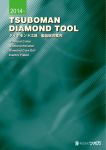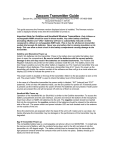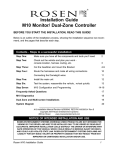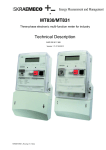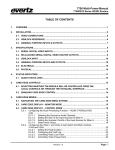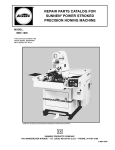Download the Micro 32 User Manual
Transcript
DIVERSITY WIRELESS SYSTEM OWNERS MANUAL ® Table of Contents Introduction 3 System Features 4 QuickStart 6 Guided Tour - M32 Receiver 7 Guided Tour - T32 Beltpack Transmitter 10 Guided Tour - H32 Handheld Microphone Transmitter 12 Setting Up and Using the Micro 32 System 14 Appendix A: T32 Multipin Wiring Guide and Chart 18 Appendix B: Channel Plan 19 Specifications 20 Produced by On The Right Wavelength for Samson Technologies Corp. Copyright 1999, Samson Technologies Corp. Printed October 1999 Samson Technologies Corp. 575 Underhill Blvd. P.O. Box 9031 Syosset, NY 11791-9031 Phone: 1-800-3-SAMSON (1-800-372-6766) Fax: 516-364-3888 Introduction Congratulations on purchasing the Samson Micro 32 Wireless System! Although this product is designed for easy operation, we suggest you first take some time to go through these pages so you can fully understand how we’ve implemented a number of unique features. Every wireless system consists of at least two components—a transmitter and a receiver, both of which must be tuned to the same channel (that is, the same radio frequency) in order to operate correctly.* The Samson Micro 32 system is frequency-agile; that is, it is capable of operating over any of a number of selectable frequencies, making it eminently suitable for touring setups or where multiple wireless systems need to be used simultaneously. Specifically, it offers 32 different operating frequencies within each of three bands (low, medium, or high), allowing up to six different Micro 32 systems to be used simultaneously in one band. The system you have purchased contains an M32 micro diversity receiver and either our T32 belt-pack transmitter (for instrument or lavalier microphone or headset applications) or H32 hand-held microphone transmitter (available in a wide variety of popular capsules). The Micro 32 system is specially designed to enable the production of professional audio tracks to accompany your video shoot or live broadcast. The use of a handheld mic transmitter or lavalier microphone connected to a beltpack transmitter effectively isolates the performer from unwanted ambient sounds such as video camera motor noise or room sounds made by the camera operator or video crew. Because the M32 receiver is extremely small and lightweight, it can be attached easily to any video camera using the supplied strip of velcro, and can even be powered directly by the camera’s own 12-volt power supply, if available. In this manual, you’ll find a QuickStart section (for those of you familiar with wireless audio systems) as well as more detailed description of the features of the Micro 32 system, a guided tour through all components, step-by-step instructions for setting up your system, wiring diagrams and tables, a channel plan and full specifications. If your Micro 32 system was purchased in the United States, you’ll also find a warranty card enclosed—don’t forget to fill it out and mail it! This will enable you to receive online technical support and will allow us to send you updated information about this and other Samson products in the future. If your Micro 32 system was purchased outside of the U. S., contact your local distributor for warranty details. Also, be sure to check out our website (http://www.samsontech.com) for complete information about our full product line. SPECIAL NOTE for U.S. purchasers: Should your Micro 32 system ever require servicing, a Return Authorization number (RA) is necessary. Without this number, the unit will not be accepted. If your Micro 32 system was purchased in the United States, please call Samson at 1-800-372-6766 for a Return Authorization number prior to shipping your unit. If possible, return the unit in its original carton and packing materials. If your Micro 32 system was purchased outside of the U. S., contact your local distributor for servicing information. * Your receiver and transmitter have been factory preset to utilize the same channel. A listing of the available channels and their corresponding UHF frequencies is presented in Appendix B on page 17 in this manual. 3 System Features Designed for use in both live sound and sound contracting applications, the Samson UHF Micro 32 Wireless System provides a high performance, cost effective solution, utilizing state-of-the-art technology in wireless communications. Its main features include: • Three bands of operation (low, medium and high), with 32 different available channels per band, all operating in the less crowded UHF bandwidth. Up to six Micro 32 systems (each tuned to a different frequency within the same band) can be used in the same location without interference. (U.S. users, who can access both the low and medium bands, have access to 64 channels and can use up to twelve Micro 32 systems in a single location.) • Optimized for use in videography applications, the Micro 32 system is highly customizable, combining a UHF “walkaround” receiver with your choice of beltpack or handheld microphone transmitters. • Using the supplied velcro strip, the compact, lightweight M32 receiver can be easily attached to any video camera and can even derive 12-volt power from the camera (if available), making it easy to integrate into any traveling or fixed installation video system. • The M32 micro diversity receiver includes a pair of tuned antennas and provides both balanced and unbalanced outputs (with a three-position output level switch) and a headphone monitor output with continuously adjustable level control. The receiver also includes an audio peak LED, dual receiver indicators, and an RF strength meter. • Technological breakthrough usage of SAW (Surface Acoustic Wave) filters (similar to those used in high-end television receivers) for extremely precise and stable tuning. • True Diversity technology maximizes active range (up to 300 feet) and reduces potential interference problems through automatic switching between two independent receivers. • Built-in companding noise reduction in all components for crystal-clear sound with minimized background noise and hiss. • Transmitters utilize PLL synthesized VCO technology to minimize spurious emissions and provide “popless” muting, which turns off the audio signal while leaving the carrier signal on. They use standard 9-volt batteries, with battery life of approximately 8 hours. Transmitters also provide a convenient three-segment multicolor Battery Strength LED meter, allowing you to monitor the remaining power in the installed battery. • The H32 hand-held microphone transmitter is available in a selection of popular mic capsules, including: Samson QMIC dynamic Audix OM-5 dynamic Electro Voice ND 757A N/DYM dynamic Electro Voice ND 857A N/DYM dynamic Shure SM85 condenser Shure SM87 condenser 4 System Features • Compact “beeper-sized” T32 belt-pack transmitter is extremely lightweight (less than 4 ounces with a 9-volt battery installed). It provides a mini-XLR jack for connection to guitar cables or a variety of popular headsets and lavalier microphones, including: Samson QE headset* Samson QV headset AKG C-410 headset Audio-Technica ATM-75 headset Audio-Technica MT-350 lavalier Audio-Technica Pro-35X wind microphone Audio-Technica AT-831 lavalier Countryman IsoMax headset Crown CM-311(E) headset Samson ECM-40 lavalier Sennheiser MKE-2 lavalier Sony ECM-44 lavalier Sony ECM-55 lavalier Sony ECM-77 lavalier • All components have rugged construction that ensures reliable operation in even the most demanding performance environments. * Optimized for aerobics workouts, this headset is recommended for usage in high-humidity environments such as physical fitness centers. 5 QuickStart If you’ve had some prior experience using wireless systems, these QuickStart instructions will get you up and running with your Micro 32 system in a matter of minutes! Detailed instructions for setting up and using your Micro 32 system can be found on page 12 of this manual, and the “Guided Tour” sections on pages 5 - 11 provide full descriptions of all Micro 32 component controls and displays. 1. Make sure that the supplied M32 receiver and T32 or H32 transmitter are factory preset to the same band (High, Medium or Low). 2. Physically place the M32 where it will be used (if desired, it can be connected to your video camera using the supplied velcro strip) and extend both of its antennas vertically. 3. If you are using the T32 with a lavalier or headset microphone, make the physical connection between its mini-XLR input connector and the microphone you are using. 4. Place a fresh battery in the transmitter and M32 receiver (or connect the M32 DC input to your video camera’s 12 volt output or optional AC300R adapter) and turn it on momentarily to check it; the multifunction LED will light green if the battery is sufficiently strong. 5. Turn your audio system off and make the physical cable connection between the M32 balanced or unbalanced output jack (if necessary, both can be used simultaneously) and the line or mic level audio input of your video camera, amplifier or mixer. If you are using the balanced output jack, be sure to set the M32 Audio Output Level switch correctly. 6. Determine the best Group and Channel to use by setting the M32 meter to “RF” and observing it while using the supplied plastic screwdriver to select different Groups and available Channels within that Group (refer to Appendix B on page 17 in this manual for a complete channel plan). Select a Group that has the greatest number of suitable Channels and the Channel within that Group that has the greatest signal strength. Remember that, when two or more transmitters and receivers are being used at the same location, all devices must be set to the same Group (each to a different Channel). 7. Turn on the transmitter and use the supplied plastic screwdriver to set it to the same Group and Channel you have selected for the receiver. Its multifunction LED will blink when selecting an unavailable Channel within a Group. 8. Set the audio gain structure by speaking or singing into your mic (or playing your instrument) at a normal performance level while slowly raising the audio input control of your video camera or audio output level of your amplifier or mixer until the desired level is reached. If necessary, use the supplied plastic screwdriver to adjust the transmitter’s AF Level trimpot in order to increase or decrease its signal level. 9. Do a walkaround through the intended area of coverage while observing the M32’s RF meter. Reposition it (or its antennas) or select a different Group/Channel as necessary. 10. If you hear any spurious noise from the M32 output when the transmitter is turned off, use the supplied plastic screwdriver to adjust the M32 Squelch level control, slowly turning it clockwise until the point at which the noise disappears. 6 Guided Tour - M32 1 A 2 3 1 UHF MICRO DIVERSITY RECEIVER LOW B MID HIGH PEAK SAMSON 4 5 MIN SQ LEVEL MAX POWER ON + 2: Meter - This set of three multicolor LEDs acts as a meter, indicating either battery power or the strength of the incoming RF signal. This meter can also be disabled altogether to conserve battery power. See #15 on the next page for more information. - 6 1: A/B Receiver LEDs - When signal is being received, one of these will be lit orange, showing you whether the (left) “A” or (right) “B” receiver is currently being used. The M32 constantly scans its two antennas and automatically selects whichever is receiving the strongest, clearest signal. This True Diversity switching is completely inaudible, but it effectively increases overall range while virtually eliminating potential interference and phase cancellation problems. 7 SAMSON 3: Peak LED - This LED lights red when output signal from the M32 is at the onset of clipping (that is, when it is on the verge of being distorted). If you see this light during operation, move the microphone further away or lower the output level of your instrument or transmitter. For more information, see the “Setting Up and Using the Micro 32 System” section on page 12 in this manual. 4: Power switch - Use this to turn the M32 power on and off. 5: SQ (Squelch) Level control - This control determines the maximum range of the M32 before audio signal dropout. Although it can be adjusted using the supplied plastic screwdriver, it should normally be left at its factory setting. See the “Setting Up and Using the Micro 32 System” section on page 12 in this manual for more information. 6: Battery holder - Insert a standard 9-volt alkaline battery here, being sure to observe the plus and minus polarity markings shown. We recommend the Duracell MN 1604 type battery. Although rechargeable Ni-Cad batteries can be used, they do not supply adequate current for more than four hours. WARNING: Do not insert the battery backwards; doing so can cause severe damage to the M32 and will void your warranty. 7: Plastic screwdriver - Specially designed for use in adjusting the M32 Squelch Level control (see #5 above). See the “Setting Up and Using the Micro 32 System” section on page 12 in this manual for more information. 7 Guided Tour - M32 8 8: Antennas (A and B) - The antenna mountings allow full rotation for optimum placement. In normal operation, both antennas should be placed in a vertical position. Both antennas can be folded inward for convenience when transporting the M32. See the “Setting Up and Using the Micro 32 System” section on page 12 in this manual for more information. 9 10 11 DC INPUT OUT UNBAL LEVEL 30 20 10 9: DC input - This jack will accept a DC input voltage of 6 - 13 volts (inner connection [tip] positive, outer connection [sleeve] ground) from your video camera, if available. Connect the optional Samson AC300R adapter here to charge a rechargeable 9-volt Ni-Cad battery. 10: Unbalanced output* - Use this unbalanced (1K Ohm max.) 1/8" (3.5 mm) mini-phone jack when connecting the M32 to consumer (-10) audio equipment. Wiring is as follows: tip hot, sleeve ground. If your video camera has stereo audio inputs, you’ll need to use a Y-adapter that has a 1/8" (3.5 mm) mini-phone plug at one end and dual male RCA-type plugs at the other end. 11: Audio Output Level switch - Sets the audio output level of both the balanced and unbalanced outputs (see #10 above and #14 below) to -30 dBm (mic level), -20 dBm, or -10 dBm (line level). See the “Setting Up and Using the Micro 32 System” section on page 12 in this manual for more information. 12 LANCED BA PHONES LEVEL P OUT UT 13 14 METER BATT. RF OFF 12: Level control - This knob sets the level of the audio signal being sent to the headphones output (see #13 below). 15 13: Headphones output - Connect a stereo headphone to this standard 1/8" (3.5 mm) mini-phone jack in order to monitor the signal being output by the M32. We recommend the use of 30 ohm headphones. The level of the headphone signal can be set by adjusting the Level control (see #12 above). Maximum output is 240 mW @ 30 ohms). 14: Balanced output* - Use this electronically balanced low impedance (600 Ohm) mini-XLR jack when connecting the M32 to professional (+4) audio equipment. Pin wiring is as follows: Pin 1 ground, Pin 2 high (hot), and Pin 3 low (cold). 15: Meter switch - This three-position switch determines the function of the M32 meter (see #2 on the previous page). In the left “RF” position, the meter indicates the strength of the incoming RF signal. In the center “BATTERY” position, the meter indicates relative battery power, showing whether the installed battery is at low (red), mid (yellow) or high (green) strength. (Note: When the red “low” indicator lights, performance is degraded and the battery needs to be replaced). In the right “OFF” position, the meter is disabled altogether, thus conserving battery power. * If required, both the unbalanced and balanced outputs can be used simultaneously. 8 Guided Tour - M32 16 17 CHANNEL 6 3 8 2 6 8 3 5 7 7 2 4 1 5 0 4 9 GROUP 16: Group selector - Use the supplied plastic screwdriver to set this to the desired Group. 17: Channel selector - Use the supplied plastic screwdriver to set this to the desired Channel. Note that only certain Channels are available within each Group; for more information, see Appendix B on page 17 in this manual. 9 0 1 UHF MICRO DIVERSITY RECEIVER FCC ID:CCRUM1 DOC ID:CAN SAMSON Technologies Corp. 9 Guided Tour - T32 1 2 3 T32 INPUT 6 8 7 MAX 1 2 GROUP CH AF LEVEL WARNING: BE SURE TO OBSERVE CORRECT BATTERY POLARITY. DURACELL MN1604 ALKALINE 9VDC BATTERY RECOMMENDED POWER + 5 - 4 MIN SAMSON 9 10 1: Antenna - This permanently attached transmitter “pig tail” antenna should be fully extended for normal operations. See the “Setting Up and Using the Micro 32 System” section on page 12 in this manual for more information about antenna positioning. 2: Multifunction LED - This multicolor LED serves several functions. First, it lights whenever the T32 is powered on (see #7 on the next page). Secondly, whenever the T32 is powered on, it shows the relative battery power, indicating whether the installed battery is at low (red), mid (orange) or high (green) strength. When it lights steadily red (“low”), RF performance is degraded and the battery needs to be replaced. Finally, the LED blinks whenever an unavailable Channel within a Group is selected. See #5 on the following page for more information and Appendix B on page 17 in this manual for a complete channel plan. 3: Input connector - The input device (instrument cable, lavalier mic, or headset mic) is connected to this mini-XLR jack. See Appendix A on page 16 for more information. 4: Group selector - Use the supplied plastic screwdriver (see #9 on the following page) to set this to the desired transmission frequency Group. 10 Guided Tour - T32 5: Channel selector - Use the supplied plastic screwdriver to set this to the desired Channel. When two or more transmitters and receivers are being used in the same location, they should be set up to use different Channels within the same Group. Note that the T32 multifunction LED (see #2 on the preceding page) blinks whenever an unavailable Channel within a Group is selected. See the “Setting Up and Using the Micro 32 System” section on page 12 and Appendix B on page 17 in this manual for more information. 6: AF Level control (trimpot) - If necessary, you can use the supplied plastic screwdriver (see #9 below) to raise or lower the T32 input level. See the “Setting Up and Using the Micro 32 System” section on page 12 in this manual for more information. 7: Power on-off switch* - Use this to turn the T32 on or off (to conserve battery power, be sure to leave it off when not in use). 8: Battery holder - Insert a standard 9-volt alkaline battery here, being sure to observe the plus and minus polarity markings shown. We recommend the Duracell MN 1604 type battery. Although rechargeable Ni-Cad batteries can be used, they do not supply adequate current for more than four hours. WARNING: Do not insert the battery backwards; doing so can cause severe damage to the T32 and will void your warranty. 9: Plastic screwdriver - Specially designed for use in adjusting the T32 AF Level control (see #6 above) and/or M32 Squelch control (see #5 on page 5). See the “Setting Up and Using the Micro 32 System” section on page 12 in this manual for more information. 10: Battery door - The T32 battery door is hinged and not intended to be removed from the transmitter case. To open it, press gently inwards on the two tabs marked “Open” on either side of the door. See the “Setting Up and Using the Micro 32 System” section on page 12 in this manual for more information. 11: Audio on-off switch - When set to the “on” position, audio signal is transmitted. When set to the “off” position, the audio signal is muted. Because the carrier signal remains during muting, no “pop” or “thud” will be heard. Note that turning this off does not turn off the transmitter power—it is simply a way to temporarily mute the transmission of audio signal. If you don’t plan on using the transmitter for extended periods, turn off the transmitter power by using the power on-off switch (see #7 above). * Be sure to mute the audio signal at your external mixer or amplifier before turning transmitter power on or off, or an audible pop may result. 3 2 11 OFF AUDIO ON 11 1 Guided Tour - H32 AU D I O ON OFF 2 1 LOW MID HIGH B AT T. L E V E L + ALKALINE IS RECOMMENDED 9V BATTERY DURACELL MN1604 IMPORTANT BATTERY POLARITY 1: Audio on-off switch - When set to the “on” position, audio signal is transmitted. When set to the “off” position, the audio signal is muted. Because the carrier signal remains during muting, no “pop” or “thud” will be heard. Note that turning this off does not turn off the transmitter power—it is simply a way to temporarily mute the transmission of audio signal. If you don’t plan on using the transmitter for extended periods, turn off the transmitter power by using the power on-off switch (see #3 below). BE SURE TO OBSERVE CORRECT H32M 5 - POWER ON AF LEVEL 3 MIN MAX 4 2: Multifunction LED - This multicolor LED serves several functions. First, it lights whenever the H32 is powered on (see #3 below). Secondly, whenever the H32 is powered on, it shows the relative battery power, indicating whether the installed battery is at low (red), mid (orange) or high (green) strength. When it lights steadily red (“low”), RF performance is degraded and the battery needs to be replaced. Finally, the LED blinks whenever an unavailable Channel within a Group is selected. See #7 on the following page for more information and Appendix B on page 17 in this manual for a complete channel plan. 3: Power on-off switch* - Use this to turn the H32 on or off (to conserve battery power, be sure to leave it off when not in use). 4: AF Level control (trimpot) - This input sensitivity control has been factory preset to provide optimum level for the particular microphone capsule provided with your Micro 32 system and so we recommend that this not be adjusted manually. If necessary, however, you can use the supplied plastic screwdriver to raise or lower the input level. See the “Setting Up and Using the Micro 32 System” section on page 12 in this manual for more information. * Be sure to mute the audio signal at your external mixer or amplifier before turning transmitter power on or off, or an audible pop may result. 12 Guided Tour - H32 FCC ID: CCRH32M Te ch n o l o g i e s C o r p . D O C I D : C A N 0 0 0 0 0 0 0 0 0 0 BA999 Z T999N 5: Battery holder - Insert a standard 9-volt alkaline battery here, being sure to observe the plus and minus polarity markings shown. We recommend the Duracell MN 1604 type battery. Although rechargeable Ni-Cad batteries can be used, they do not supply adequate current for more than four hours. WARNING: Do not insert the battery backwards; doing so can cause severe damage to the H32 and will void your warranty. TRANSMITTER MODEL H32 Note: As shown in the illustration on the left, the controls for setting the H32 Group and Channel indicated below are located on the opposite side to the battery compartment: 8 7 6 5 4 CH 0 9 5 4 3 2 1 3 2 1 GR 8 7 6 0 9 6: Group selector - Use the supplied plastic screwdriver to set this to the desired transmission frequency Group. 7: Channel selector - Use the supplied plastic screwdriver to set this to the desired Channel. When two or more transmitters and receivers are being used in the same location, they should be set up to use different Channels within the same Group. Note that the H32 multifunction LED (see #2 on the preceding page) blinks whenever an unavailable Channel within a Group is selected. See the “Setting Up and Using the Micro 32 System” section on page 12 and Appendix B on page 17 in this manual for more information. 7 6 13 Setting Up and Using the Micro 32 System The basic procedure for setting up and using your Micro 32 Wireless System takes only a few minutes: 1. For the Micro 32 system to work correctly, both the receiver and transmitter must be set to the same band (labeled “Low,” “Medium” and “High”). Remove all packing materials (save them in case of need for future service) and check to make sure that the supplied M32 receiver and T32 or H32 transmitter are factory preset to the same band. If these do not match, contact your distributor or, if purchased in the United States, call Samson Technical Support at 1-800-372-6766. 2a. If you are using a 9-volt battery to power the M32, press gently down on the battery door release (on the front of the M32, on the word “Open”) and swing the door open in order to access the battery compartment . Note that the door is hinged and is not intended to be removed from the receiver case. Insert a 9-volt battery, being careful to observe the polarity markings. Warning: Reversing the battery polarity may cause permanent damage to your receiver. Turn the power switch “On” and set the Meter switch to “BATTERY.” The green “HIGH” meter LED will light if the battery is sufficiently strong. Once you’ve verified battery strength, turn the power switch “Off” again. 2b. If you are using the optional Samson AC300R adapter or your video camera’s 12-volt power supply to power the M32, connect it to the M32 DC input jack. On the front of the M32, press gently down on the battery door release (on the word “Open”) and swing the door open note that the door is hinged and is not intended to be removed from the receiver case). Make sure the power switch is set to “Off.” 3. If you are using the T32 beltpack transmitter with a permanently attached instrument cable, skip ahead to step 4a below. If you are using the T32 with a lavalier or headset microphone, make the physical connection between its mini-XLR input connector and the microphone you are using. Because the mini-XLR plug is “keyed,” you’ll need to rotate it a certain way to get it to “mate” with the connector mounted on the T32; then push straight down until you hear a click. To remove the mini-XLR connector, press in the black dot on the plug and pull straight out (do not use force!). Never pull on the wire, only the plug itself (with the black dot pressed in). 4a. If your system contains a T32 belt-pack transmitter, make sure its pigtail antenna is extended fully and then press gently inwards on the two tabs marked “Open” (on the sides of the case) to open the battery door, which is hinged and not intended to be removed from the transmitter case. Please use care when opening this door as undue force will destroy the hinge. 4b. If your system contains a H32 handheld transmitter, unscrew the bottom section of the microphone by turning it counterclockwise and then slide it off. 5. Place a fresh 9-volt alkaline battery in the transmitter battery holder, taking care to observe the polarity markings. If you are using a T32 belt-pack transmitter, gently replace the battery door by swinging it up and pressing until it clicks. If you are using a H32 handheld transmitter, replace the bottom section of the microphone by sliding it on and then screwing it back on. Whichever transmitter you are using, leave it off for the moment. 14 Setting Up and Using the Micro 32 System 6. To check the battery strength, turn on the power to the T32 or H32 transmitter (using its Power on-off switch). The multifunction LED will light green if the battery is sufficiently strong. Once you’ve established that the installed battery has sufficient power, use the Power on-off switch to turn the transmitter off again. 7. Make the physical cable connection between the output of your M32 receiver and the audio input of your video camera or audio amplifier or mixer, being careful to set the Audio Output Level switch so that the signal is strong but not distorting. Normally, it should be set to the “-30” position when connecting to a mic-level input and to the “-20” or “-10” position when connecting to a line-level input. If required, both the balanced and unbalanced outputs can be used simultaneously. Leave your amplifier (and/or mixer) off at this time. 8. Next, select the Group and Channel for your transmitters and receivers. When two or more transmitters and receivers are being used at the same location, all devices must be set to the same Group (though each transmitter/receiver pair must use its own Channel) or intermodulation noise may occur. With the power to your transmitter off, set the M32 Meter switch to the left “RF” position, then use the supplied plastic screwdriver to set the M32 Group and Channel trimpots to an available channel within a Group. (Refer to Appendix B on page 17 in this manual for a complete channel plan.) Next, turn on the transmitter and set it to the same Group and Channel (its multifunction LED will blink whenever an unavailable Channel within a Group is selected). One or more segments in the M32 meter should then light. If the “HIGH” segment lights, the M32 is receiving an optimally strong RF signal. If the “LOW” segment lights (indicating a relatively weak RF signal), try a different Channel within the Group or a different Group/Channel altogether—you will find that some have stronger signals than others. Always pick the Channel that has the strongest signal. 9. Next, it’s time to set the audio gain structure. Turn on your connected amplifier and/or mixer but keep its volume all the way down. Make sure that your transmitter is unmuted by setting its Audio switch to “On.” If you are using the H32 transmitter or if you are using the T32 transmitter with a connected lavalier microphone or headset, speak or sing into the mic at a normal performance level while slowly raising the volume of your amplifier/mixer until the desired level is reached. If you are using the T32 transmitter with a connected instrument, play the instrument at normal performance level while slowly raising the volume of your amplifier/mixer until the desired level is reached. If you are using a lavalier microphone, correct placement is critical to sound quality. We recommend that you position it as shown in the illustration on the right—as close to your mouth as possible but off to one side (to minimize nasality) and unobstructed by clothing. Bear in mind also that omnidirectional microphones (mics which pick up signal from all directions) are more prone to feedback problems than unidirectional (cardioid or supercardioid) ones; in general, you can avoid feedback by taking care not to use any microphone directly in front of a PA speaker (if this is unavoidable, you can try using an equalizer to attenuate those high frequencies which are causing the feedback “squealing”). T32 INPUT SAMSON 15 Setting Up and Using the Micro 32 System 10. If you hear distortion at the desired volume level, first check to see whether the red “Peak” LED on the M32 is lighting. If it is not, make sure that the gain structure of your audio system is correctly set (consult the owners manual of your mixer and/or amplifier for details). If the red “Peak” LED does light, do the following: • If you are using an H32 transmitter, use the supplied plastic screwdriver to turn its AF Level control (trimpot) slowly counterclockwise (towards the “Min” position) until the distortion disappears. • If you are using a T32 transmitter with connected lavalier microphone or headset, its AF Level control has been factory preset to provide optimum level for the particular lavalier or headset model being used and so no adjustment should be necessary. Any distortion present should therefore simply be a matter of the microphone being too close to the mouth; try moving it further away. If this does not solve the problem, use the supplied plastic screwdriver to turn the AF Level control (trimpot) on the T32 slowly counterclockwise until the distortion disappears. If you are using a T32 transmitter with an instrument such as electric guitar or bass, lower the output level of the instrument until the distortion disappears. Alternatively, you can use the supplied plastic screwdriver to turn the AF Level control (trimpot) on the T32 slowly counterclockwise until the distortion disappears. 11. Conversely, if you hear a weak, noisy signal at the desired volume level, again make sure that the gain structure of your audio system is correctly set (consult the owners manual of your mixer and/or amplifier for details). If it is and the signal coming from the M32 is still weak and/or noisy, do the following: • If you are using an H32 transmitter, use the supplied plastic screwdriver to turn the AF Level control (trimpot) on the transmitter slowly clockwise (towards the “Max” position) until the signal reaches an acceptable level. • If you are using a T32 transmitter with connected lavalier microphone or headset, its Level control has been factory preset to provide optimum level for the particular lavalier or headset model being used and so no adjustment should be necessary. Any weakness of signal should therefore simply be a matter of the microphone being too far from the mouth; try moving it closer. If this does not solve the problem, use the supplied plastic screwdriver to turn the AF Level control (trimpot) on the T32 slowly clockwise until the signal reaches an acceptable level. If you are using a T32 transmitter with an instrument such as electric guitar or bass, raise the output level of the instrument until a good signal is achieved. Alternatively, you can use the supplied plastic screwdriver to turn the AF Level control (trimpot) on the T32 slowly clockwise until the signal reaches an acceptable level. 12. If you want to use headphones to monitor the transmission, connect a standard “Walkman”-type 30 ohm headphone to the M32 headphone output and adjust the Level control until the desired level is reached. 13. When first setting up the Micro 32 system in a new environment, it’s always a good idea to do a walkaround in order to make sure that coverage is provided for your entire performance area. Accordingly, turn on both the transmitter and M32 receiver. If you are using a video camera, use the supplied velcro strip to attach the M32 to the side of the 16 Setting Up and Using the Micro 32 System camera. If not, physically place the M32 in the position in which it will be used. Next, with the transmitter unmuted, walk through the entire area that will need to be covered while speaking, singing, or playing your instrument. As you do so, you will find that the orange “A” and “B” LEDs on the M32 occasionally switch on or off, always showing you which antenna is receiving the stronger signal. The basic rule of thumb for successful wireless installations is to always try to minimize the distance between transmitter and receiver as much as possible and also to try to maintain “line of sight” between the two (so that the person using the transmitter can see the receiver antennas). You may also be able to improve RF reception by relocating the receiver or repositioning one or both of the receiver antennas. 13. Temporarily turn down the level of your mixer/amplifier system and turn off the power to your transmitter, leaving the M32 on. Then restore the previously set level of your mixer/amplifier. With the transmitter off, the receiver output should be totally silent—if it is, skip ahead to the next step. If it isn’t (that is, if you hear some noise), you may need to adjust the M32 Squelch level control. When the Squelch level control is at its minimum setting, the Micro 32 system always provides maximum range without dropout; however, depending upon the particular environment your system is used in, you may need to reduce that range somewhat in order to eliminate band noise when the transmitter is turned off. To do so, use the provided screwdriver to rotate the Squelch level control completely counterclockwise (to the “Min” position), then slowly turn it clockwise until the noise disappears. If no noise is present at any position, leave it at its fully counterclockwise “Min” position (so as to have the greatest overall range available). If you have followed all the steps above and are experiencing difficulties, contact your local distributor or, if purchased in the United States, call Samson Technical Support (1-800-372-6766) between 9 AM and 5 PM EST. 17 Appendix A: T32 Multipin Wiring Guide and Chart 1 MANUFACTURER SAMSON 2 3 4 MODEL ECM40 PIN 1 PIN 2 PIN 3 SHIELD WHITE JUMP TO PIN 2 QE/QV SHIELD WHITE RED JUMP TO PIN 2 C410 SHIELD RED WHITE JUMP TO PIN 2 AUDIO TECHNICA AT831 YELLOW x 2 SHIELD RED x 2 JUMP TO PIN 2 AUDIO TECHNICA ATM75 YELLOW x 2 SHIELD RED x 2 JUMP TO PIN 2 AUDIO TECHNICA ATPRO8HE YELLOW x 2 SHIELD N/C RED x 2 AUDIO TECHNICA ATPRO35X YELLOW x 2 SHIELD RED x 2 JUMP TO PIN 2 AUDIO TECHNICA MT350 SHIELD WHITE JUMP TO PIN 2 COUNTRYMAN ISOMAX SHIELD WHITE JUMP TO PIN 2 CM311(E) SHIELD WHITE RED JUMP TO PIN 2 RED JUMP TO PIN 2 SAMSON AKG CROWN SENNHEISER MKE2 SHIELD BLUE SENNHEISER MKE40 SHIELD BLUE RED JUMP TO PIN 2 SENNHEISER MKE48 SHIELD BLUE RED JUMP TO PIN 2 ECM44/55 SHIELD WHITE RED JUMP TO PIN 2 RED JUMP TO PIN 2 SONY SONY ECM77 SHIELD WHITE SONY ECM144 SHIELD WHITE JUMP TO PIN 2 SHIELD N/C AUDIO GROUND +Vdc AUDIO GUITAR PIN INFORMATION Procedure for wiring T32 connector: Unscrew rubber boot 1 and pass wire through 1 and 2. Solder wire to 3 after removing from 4 (use chart above). Reinsert 3 to 4 with attached wire (3 is keyed to fit 4). Plug 2 into 3 again (2 is keyed to 3) and crimp wire. Rescrew rubber boot 1 to 4. 18 Appendix B: Channel Plan Low Band (MHz): Chan.: Grp. 0 Grp. 1 Grp. 2 Grp. 3 Grp. 4 Grp. 5 Grp. 6 Grp. 7 Grp. 8 Grp. 9 0 778.125 779.375 780.625 781.875 1 778.375 778.125 778.250 778.625 778.750 779.625 778.250 779.500 780.750 782.000 2 778.875 778.375 778.500 778.875 779.500 780.125 778.375 779.625 780.875 3 780.125 779.125 779.000 779.375 780.000 780.375 778.500 779.750 781.000 4 780.750 779.750 779.875 780.250 781.125 780.750 778.625 779.875 781.825 5 781.500 781.000 780.500 780.625 781.375 781.625 778.750 780.000 781.250 6 7 8 9 781.750 781.500 780.875 781.250 781.750 778.875 779.000 779.125 779.250 780.125 780.250 780.375 780.500 781.375 781.500 781.625 781.750 Medium Band (MHz): Chan.: Grp. 0 Grp. 1 Grp. 2 Grp. 3 Grp. 4 Grp. 5 Grp. 6 Grp. 7 Grp. 8 Grp. 9 0 801.125 802.375 803.625 804.875 1 801.375 801.125 801.250 801.625 801.750 802.625 801.250 802.500 803.750 805.000 2 801.875 801.375 801.500 801.875 802.500 803.125 801.375 802.625 803.875 3 803.125 802.125 802.000 802.375 803.000 803.375 801.500 802.750 804.000 4 803.750 802.750 802.875 803.250 804.125 803.750 801.625 802.875 804.125 5 804.500 804.000 803.500 803.625 804.375 804.625 801.750 803.000 804.250 6 7 8 9 804.750 804.500 803.875 804.250 804.750 801.875 802.000 802.125 802.250 803.125 803.250 803.375 803.500 804.375 804.500 804.625 804.750 High Band (MHz): Chan.: 0 Grp. 0 Grp. 1 Grp. 2 Grp. 3 Grp. 4 Grp. 5 Grp. 6 Grp. 7 Grp. 8 Grp. 9 856.500 856.500 854.900 855.400 855.900 856.400 856.900 857.400 857.900 858.400 1 857.025 857.025 854.950 855.450 855.950 856.450 856.950 857.450 857.950 858.450 2 857.500 857.500 855.000 855.500 856.000 856.500 857.000 857.500 858.000 858.500 3 858.250 858.250 855.050 855.550 856.050 856.550 857.050 857.550 858.050 858.550 4 858.700 858.700 855.100 855.600 856.100 856.600 857.100 857.600 858.100 858.600 19 5 6 7 8 9 857.625 857.950 858.200 858.650 855.150 855.650 856.150 856.650 857.150 857.650 858.150 858.650 855.200 855.700 856.200 856.700 857.200 857.700 858.200 858.700 855.250 855.750 856.250 856.750 857.250 857.750 858.250 858.750 855.300 855.800 856.300 856.800 857.300 857.800 858.300 858.800 855.350 855.850 856.350 856.850 857.350 857.850 858.350 858.850 Specifications System Specifications: Channels Frequency Type Modulation Type Noise Reduction Type Distance 32 per band (3 bands) F3E FM Compander 100 meters from visible receiver Transmitter (H32, T32): Oscillation Type Modulation Type Pre-emphasis Antenna Input (T32) Maximum Input Level Battery Battery life Operating Temperature Switches / Controls Display (LED) Operating Voltage Current Consumption RF Output Power Frequency Stability Spurious Ratio Deviation T.H.D. (Overall) AF Frequency Response Input Impedance Dimensions H32 T32 Weight H32 T32 Crystal-controlled PLL frequency synthesized Variable reactance 50 µsec 1/4 wave length; H32: integral dipole; T32: wire (permanently attached) MIC input with phantom power, INST input jack (27 dB attenuator at MIC input terminal) -8 dBv Duracell MN1604 9-volt alkaline 8 hours @ 25° C (without phantom power) 0° C / 50° C Power ON/OFF, Audio ON/OFF Group switch, Channel switch, Level volume Battery Low/Mid/High (corresponds to <5.3 V / 5.3 - 7 V / >7V) 9 Volts +20% / -40% 55 mA 10 mW ±15 kHz 1 uW 15 kHz (13 kHz - 17 kHz) 2% max (@1 kHz, DEV 15 kHz) 50 Hz - 15 kHz (±3.5 dB overall) H32: 100 Ohms; T32: 82. k Ohms (MIC input), 8.2 k Ohms (INST input) (without microphone head) 37 mm (Dia) x 151 (H) (1.4 x 5.9 in.) 102 mm (W) x 66 (H) x 24 (D) (4 x 2.6 x .9 in.) (without battery, microphone head): 65 grams • 2.3 oz. (without battery, input cable): 80 grams • 2.8 oz. Receiver (M32): Oscillation Type Receiving Method De-emphasis IF Frequency Local Frequency Antenna In/Out Crystal Controlled Single Super Heterodyne / True Diversity 50 µsec 10.7 MHz 70 MHz Range (79 - 79.5 MHz) 1/4 Wavelength Rod 5.5 DC Inlet, Balanced Output (Switchcraft TA3F mini-XLR), Unbalanced Output (3.5 mm phone jack), Headphone Output (3.5 mm phone jack) Display (LED) Receiver A/B (Orange), Peak (Red), RF Level / Battery Strength (3 pc) Peak LED lighting point AF output level approx. +4 dB Controls Group switch, Channel switch, Audio Level switch, Squelch volume, Headphone volume, Meter function switch Operating Temperature 0° C / 55° C Operating Voltage AC adapter DC 6 - 13 Volts, 9 volts battery Current Consumption >60 mA (no signal, all LEDs off) Receiving Frequency Range 778.125 - 858.850 MHz Squelch Sensitivity 17 dBµv ±4 dB T.H.D. (Overall) 1% Max (@AF 1 kHz, RF 56 dBuv) Dynamic Range 95 dB (w/IHF-A Filter) AF Frequency Response 50 Hz - 15 kHz (±3 dB overall) Audio Output Level 0 dBv ±2 dB (Maximum +9 dBV ±3 dB @ 3% THD) Audio Output Impedance 1 k Ohms max. (Unbalanced), 600 Ohms (Balanced) Headphone Output Impedance 32 Ohms Battery life 12 hours typical 20 FCC Rules and Regulations Samson wireless systems are type accepted under FCC rules parts 90, 74 and 15. Licensing of Samson equipment is the user’s responsibility and licensability depends on the user’s classification, application and frequency selected. This device complies with RSS-210 of Industry & Science Canada. Operation is subject to the following two conditions: (1) this device may not cause harmful interference and (2) this device must accept any interference received, including interference that may cause undesired operation.


































